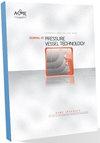复合材料圆柱壳结构在静水压力作用下的优化设计
IF 1.4
4区 工程技术
Q4 ENGINEERING, MECHANICAL
Journal of Pressure Vessel Technology-Transactions of the Asme
Pub Date : 2022-08-05
DOI:10.1115/1.4055159
引用次数: 4
摘要
当深海结构潜入阈值以下时,该结构将在静水压力下坍塌/内爆,导致结构不稳定和灾难性失效。为了更好地理解复合材料圆柱壳的叠层角如何影响这一不稳定阈值,本工作探讨了复合材料圆柱如何在静水载荷条件下达到最高(最佳)临界坍塌压力。为了进行该分析,将先前工作开发的闭合形式分析圆柱屈曲解决方案与玻璃、碳的不同圆柱几何配置和复合材料性能以及编织和单向结构的板内混合复合材料性能结合使用。结果表明,复合材料结构的最佳铺层配置是结构几何形状和材料系统所独有的。然而,观察到这些不同系统的总体趋势,例如对称和不对称结构如何将轴向阻力层放置在复合材料系统的中性面附近。此外,无论材料系统如何,随着L/D比的降低,两种结构都需要增加抗剪层。最后,本文提出的分析方法可用于准确确定承受外部静水压力的复合材料圆柱结构的最佳叠合角。本文章由计算机程序翻译,如有差异,请以英文原文为准。
Optimization of Composite Cylindrical Shell Structures for Hydrostatic Pressure Loading
Deep-sea structures will collapse/implode under hydrostatic pressure when the structure dives below a threshold, leading to structural instability and catastrophic failure. To better understand how the layup angle of composite cylindrical shells influences this instability threshold, the present work explores how composite cylinders can achieve the highest (optimum) critical collapse pressure under hydrostatic loading conditions. To perform this analysis, a closed-form analytical cylinder buckling solution developed by previous work is used in conjunction with different cylindrical geometrical configurations and composite properties for glass, carbon, and intraply-hybrid composite properties for woven and unidirectional structures. The results show that a composite structure's optimum layup configuration is unique to the structure's geometry and material system. However, general trends are observed for these different systems, such as how symmetric and asymmetric constructions place the axial-resistant layers near the neutral plane of the composite system. In addition, both constructions need an increase in shear-resistance layers as the L/D ratio decreases regardless of the material system. Lastly, the analytical approach presented in this work can be used to accurately determine the optimum layup angle for composite cylindrical structures that are subjected to external hydrostatic pressure.
求助全文
通过发布文献求助,成功后即可免费获取论文全文。
去求助
来源期刊
CiteScore
2.10
自引率
10.00%
发文量
77
审稿时长
4.2 months
期刊介绍:
The Journal of Pressure Vessel Technology is the premier publication for the highest-quality research and interpretive reports on the design, analysis, materials, fabrication, construction, inspection, operation, and failure prevention of pressure vessels, piping, pipelines, power and heating boilers, heat exchangers, reaction vessels, pumps, valves, and other pressure and temperature-bearing components, as well as the nondestructive evaluation of critical components in mechanical engineering applications. Not only does the Journal cover all topics dealing with the design and analysis of pressure vessels, piping, and components, but it also contains discussions of their related codes and standards.
Applicable pressure technology areas of interest include: Dynamic and seismic analysis; Equipment qualification; Fabrication; Welding processes and integrity; Operation of vessels and piping; Fatigue and fracture prediction; Finite and boundary element methods; Fluid-structure interaction; High pressure engineering; Elevated temperature analysis and design; Inelastic analysis; Life extension; Lifeline earthquake engineering; PVP materials and their property databases; NDE; safety and reliability; Verification and qualification of software.

 求助内容:
求助内容: 应助结果提醒方式:
应助结果提醒方式:


